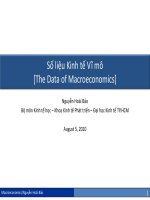- Trang chủ >>
- Đại cương >>
- Kinh tế vi mô
bài giảng kinh tế vi mô chương 2:lý thuyết về sự lựa chọn của nguwoif tiêu dùng - ts. nguyễn tiến dũng
Bạn đang xem bản rút gọn của tài liệu. Xem và tải ngay bản đầy đủ của tài liệu tại đây (493.31 KB, 73 trang )
The Theory of
Consumer Choice
Bài 2: L
ý thuyết về sự
lựa chọn của người
tiêu dùng
Harcourt, Inc. items and derived items copyright © 2001 by Harcourt, Inc.
The theory of consumer choice
addresses the following questions:
Do all demand curves slope downward?
How do wages affect labor supply?
How do interest rates affect household saving?
Do the poor prefer to receive cash or in-kind
transfers?
Lý thuyết về sự lựa chọn của người tiêu dùng giải
quyết những câu hỏi sau:
Phải chăng mọi đường cầu đều dốc xuống?
Tiền lương ảnh hưởng như thế nào đến cung về
lao động?
Lãi suất ảnh hưởng đến tiết kiệm của hộ gia đình
như thế nào?
Người nghèo thích nhận trợ cấp bằng tiền mặt
hay hiện vật?
Harcourt, Inc. items and derived items copyright © 2001 by Harcourt, Inc.
The Budget Constraint
The budget constraint depicts the consumption
“bundles” that a consumer can afford.
People consume less than they desire because
their spending is constrained, or limited, by their
income.
Sự ràng buộc
ngân sách
Giới hạn (sự ràng buộc) ngân sách mô tả khả năng
tiêu dùng mà người tiêu dùng có khả năng.
Mọi người thừơng tiêu dùng ít hơn so với mức mà
họ mong muốn bởi vì chi tiêu của họ bị giới hạn,
hay ràng buộc bởi thu nhập của họ.
Harcourt, Inc. items and derived items copyright © 2001 by Harcourt, Inc.
The Budget Constraint
It shows the various combinations of goods
the consumer can afford given his or her
income and the prices of the two goods.
Gi
ới hạn ngân sách
Giới hạn ngân sách thể hiện các sự kết hợp
khác nhau của hàng hoá mà người tiêu dùng
có khả năng mang lại và giá của hai loại
hàng hoá đó.
Harcourt, Inc. items and derived items copyright © 2001 by Harcourt, Inc.
The Consumer’s Opportunities
Pints of
Pepsi
Number of
Pizzas
Spending
on Pepsi
Spending
on Pizza
Total
Spending
0 100 $ 0 $1,000 $1,000
50 90 100 900 1,000
100 80 200 800 1,000
150 70 300 700 1,000
200 60 400 600 1,000
250 50 500 500 1,000
300 40 600 400 1,000
350 30 700 300 1,000
400 20 800 200 1,000
450 10 900 100 1,000
500 0 1,000 0 1,000
Copyright © 2001 by Harcourt, Inc. All rights reserved
Harcourt, Inc. items and derived items copyright © 2001 by Harcourt, Inc.
The Consumer’s Budget
Constraint
Any point on the budget constraint line indicates the
consumer’s combination or tradeoff between two goods.
For example, if the consumer buys no pizzas, he can afford
500 pints of Pepsi (point B). If he buys no Pepsi, he can
afford 100 pizzas (point A).
Gi
ới hạn ngân sách của người tiêu dùng
Bất cứ điểm nào nằm trên đường giới hạn ngân sách đều chỉ
ra sự kết hợp hoặc trao đổi 2 loại hàng hoá đó của người tiêu
dùng.
Ví dụ, nếu người tiêu dùng không mua pizza, anh ta có khả
năng mua 500lon pepsi (điểm B). Nếu người tiêu dùng không
mua pepsi, anh ta có khả năng mua 100 bánh pizza (điểm A).
Harcourt, Inc. items and derived items copyright © 2001 by Harcourt, Inc.
The Consumer’s Budget
Constraint
Quantity
of Pizza
Quantity
of Pepsi
0
Consumer’s
budget constraint
500
B
100
A
Harcourt, Inc. items and derived items copyright © 2001 by Harcourt, Inc.
The Consumer’s Budget
Constraint
Alternately, the consumer can buy
50 pizzas and 250 pints of Pepsi.
Gi
ới hạn ngân sách của người
tiêu dùng
L
ần lượt, người tiêu dùng có thể mua 50
bánh pizza và 250 lon Pepsi
Harcourt, Inc. items and derived items copyright © 2001 by Harcourt, Inc.
The Consumer’s Budget
Constraint
Quantity
of Pizza
Quantity
of Pepsi
0
250
50 100
500
B
C
A
Consumer’s
budget constraint
Harcourt, Inc. items and derived items copyright © 2001 by Harcourt, Inc.
The Consumer’s Budget
Constraint
The slope of the budget constraint line equals the
relative price of the two goods, that is, the price of one
good compared to the price of the other.
It measures the rate at which the consumer will trade
one good for the other.
Gi
ới hạn ngân sách của người
tiêu dùng
Độ dốc của đường giới hạn ngân sách bằng giá
tương đối giữa hai loại hàng hoá, giá của hàng
hoá này so với hàng hóa kia.
Nó phản ánh tỷ lệ mà người tiêu dùng có thể
trao đổi hàng hoá này lấy hàng hoá kia.
Harcourt, Inc. items and derived items copyright © 2001 by Harcourt, Inc.
Preferences:
What the Consumer Wants
A consumer’s preference among
consumption bundles may be
illustrated with indifference curves.
S
ở thích:
C
ái mà người tiêu
dùng muốn có
S
ở thích của người tiêu dùng được biểu
thị bằng các đường bàng quan
Harcourt, Inc. items and derived items copyright © 2001 by Harcourt, Inc.
Representing Preferences with
Indifference Curves
An indifference curve shows
bundles of goods that make the
consumer equally happy.
M
ột đường bàng quan thể hiện những
rổ hàng hoá mà làm cho người tiêu
dùng thoả mãn như nhau.
Harcourt, Inc. items and derived items copyright © 2001 by Harcourt, Inc.
The Consumer’s Preferences
Quantity
of Pizza
Quantity
of Pepsi
0
C
B
A
Indifference
curve,
I
1
D
I
2
Harcourt, Inc. items and derived items copyright © 2001 by Harcourt, Inc.
The consumer is indifferent, or equally
happy, with the combinations shown at
points A, B, and C because they are all on
the same curve.
The Consumer’s Preferences
S
ự lựa chọn tối ưu của người tiêu dùng
Người tiêu dùng thì bàng quan, hoặc thoả
mãn như nhau, với sự kết hợp đựơc thể hiện
tại điểm A, B và C do tất cả chúng cùng nằm
trên một đường bàng quan giống nhau.
Harcourt, Inc. items and derived items copyright © 2001 by Harcourt, Inc.
The Marginal Rate of Substitution
The slope at any point on an indifference curve is the
marginal rate of substitution.
It is the rate at which a consumer is willing to substitute
one good for another.
It is the amount of one good that a consumer requires as
compensation to give up one unit of the other good.
Tỷ lệ thay thế cận biên
Độ dốc của bất kỳ điểm nào nằm trên đừơng bàng quan là tỷ
lệ thay thế cận biên.
Đó là tỷ lệ mà tại đó người tiêu dùng sẵn sàng thay thế
hàng hoá này bằng hàng hoá khác.
Đó là một lượng mà người tiêu dùng muốn nhận đựơc để
sẵn sàng từ bỏ một hàng hoá khác.
Harcourt, Inc. items and derived items copyright © 2001 by Harcourt, Inc.
The Consumer’s Preferences
Quantity
of Pizza
Quantity
of Pepsi
0
C
B
A
D
Indifference
curve,
I
1
I
2
1
MRS
Harcourt, Inc. items and derived items copyright © 2001 by Harcourt, Inc.
Properties of Indifference Curves
Higher indifference curves are preferred to
lower ones.
Indifference curves are downward sloping.
Indifference curves do not cross.
Indifference curves are bowed inward.
C
ác tính chất của đường bàng quan
Các đường bàng quan cao hơn được ưa thích
hơn những đường bàng quan thấp hơn.
Các đường bàng quan dốc xuống.
Các đường bàng quan không thể cắt nhau.
Các đường bàng quan đều lồi vào phía trong.
Harcourt, Inc. items and derived items copyright © 2001 by Harcourt, Inc.
Property 1: Higher indifference curves are
preferred to lower ones.
Quantity
of Pizza
Quantity
of Pepsi
0
C
B
A
D
Indifference
curve,
I
1
I
2
Harcourt, Inc. items and derived items copyright © 2001 by Harcourt, Inc.
Property 1: Higher indifference curves are
preferred to lower ones.
Consumers usually prefer more of something to
less of it.
Higher indifference curves represent larger
quantities of goods than do lower indifference
curves.
Tính chất 1: Các đường bàng quan cao hơn đựơc ưa
thích hơn những đường bàng quan thấp hơn
Người tiêu dùng thường ưa thích một cái gì đó
nhiều hơn so với ít hơn.
Các đường bàng quan cao hơn biểu thị lượng
hàng hoá lớn hơn so với những đường bàng quan
thấp.
Harcourt, Inc. items and derived items copyright © 2001 by Harcourt, Inc.
Property 2: Indifference curves are
downward sloping.
Quantity
of Pizza
Quantity
of Pepsi
0
Indifference
curve,
I
1
Harcourt, Inc. items and derived items copyright © 2001 by Harcourt, Inc.
Property 2: Indifference curves are
downward sloping.
A consumer is willing to give up one good only if he or she
gets more of the other good in order to remain equally
happy.
If the quantity of one good is reduced, the quantity of the
other good must increase.
For this reason, most indifference curves slope downward.
T
ính chất 2: Các đường bàng quan dốc xuống
Người tiêu dùng sẵn sàng thay thế hàng hoá này bằng hàng
hoá khác nếu anh ta nhận nhiều hàng hoá khác hơn nhằm
làm cho mức thoả mãn của người tiêu dùng không thay đổi.
Nếu lượng của hàng hoá này giảm, lượng hàng hoá kia sẽ
tăng.
Với lý do này, hầu hết các đường bàng quan dốc xuống.
Harcourt, Inc. items and derived items copyright © 2001 by Harcourt, Inc.
Property 3: Indifference curves do not
cross.
Quantity
of Pizza
Quantity
of Pepsi
0
C
A
B
Harcourt, Inc. items and derived items copyright © 2001 by Harcourt, Inc.
Property 3: Indifference curves do not cross.
Points A and B should make the consumer equally happy.
Points B and C should make the consumer equally happy.
This implies that A and C would make the consumer equally
happy.
But C has more of both goods compared to A.
T
ính chất 3: Các đường bàng quan không thể
cắt nhau
Điểm A và B đem lại mức độ thoả mãn như nhau.
Điểm B và C đem lại mức độ thoả mãn như nhau.
Hàm ý điểm A và C đem lại mức độ thoả mãn như nhau.
Nhưng tại C cả hai loại hàng hoá đều nhiều hơn ở A.
Harcourt, Inc. items and derived items copyright © 2001 by Harcourt, Inc.
Property 4: Indifference curves are
bowed inward.
People are more willing to trade away goods that they have in
abundance and less willing to trade away goods of which they
have little.
These differences in a consumer’s marginal substitution rates
cause his or her indifference curve to bow inward.
Tính chất 4: Các đường bàng quan đều lồi
vào phía trong
Mọi người thường sẵn sàng hơn trong việc từ bỏ
những loại hàng hoá mà họ đang tiêu dùng nhiều và
ít sẵn sàng hơn trong việc từ bỏ những loại hàng hoá
mà họ đang tiêu dùng ít.
Sự khác nhau trong tỷ lệ thay thế cận biên gây cho
đường bàng quan lồi vào trong.
Harcourt, Inc. items and derived items copyright © 2001 by Harcourt, Inc.
1
MRS
= 1
8
3
Indifference
curve
A
Property 4: Indifference curves are
bowed inward.
Quantity
of Pizza
Quantity
of Pepsi
0
14
2
3
7
B
1
MRS
= 6
4
6









